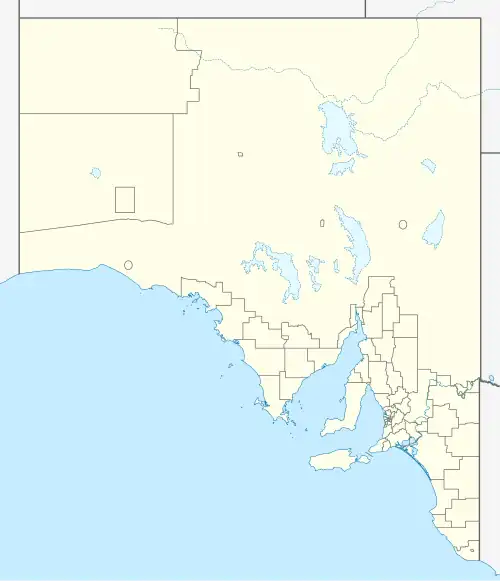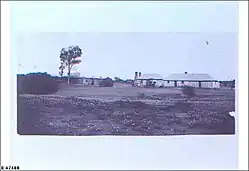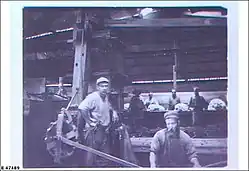Nilpena

31°00′43″S 138°13′41″E / 31.012°S 138.228°E Nilpena Station is a former pastoral lease in the northern Flinders Ranges in South Australia, since August 2025 acquired by the South Australian Government to become part of the Nilpena Ediacara National Park. Originally acquired by Thomas Elder and Robert Barr Smith in 1859, the property changed hands and uses as a sheep station and then cattle station over the years, until acquired by the Fargher family in the early 1980s. In 1985, the owners discovered Ediacaran fossils on the station, leading to further research and study by scientists on the property. In 2019, two-thirds of the property was sold to the Government of South Australia, to become part of the Nilpena Ediacara National Park when proclaimed in 2021. In August 2025, the rest of the property was sold to the government, enlarging the area of the national park and ensuring that the fossils are protected. The property is part of a bid for a large area of the Flinders Ranges to become a World Heritage Site.
History


Thomas Elder and Robert Barr Smith acquired Nilpena in 1859.[1]
William James Browne owned the property in 1879 when he had the drover Giles take 12,000 sheep from Nilpena and overland them all the way to his new properties Newcastle Waters and Delamere Stations. Only 8000 sheep survived the journey, but it was still regarded as one of the most remarkable droving feats in Australian history.[2] Browne appointed Roderick John Matheson to manage the property, along with Arkaba Station.[3] Matheson and John Lewis later bought Nilpena, with Matheson later buying out Lewis.
In 1925, the Old Nilpena Station was placed on the market for auction. At this time it occupied 31,404 acres (127.09 km2)[4] and was stocked with over 3000 merino sheep. It failed to reach the reserve price of £11,750.[5]
Matheson still owned the property in 1926, along with neighbouring Warrioota Station, which together occupied an area of 350 square miles (906 km2). He was running about 15,000 sheep across the two properties.[6] Colin Matheson and his wife had taken over by 1931.[7]
For some time in the 1930s through to the early 1950s, both sheep and cattle were run on the property.[8][9][10][11] In 1944 the property was carrying 7000 sheep.[12]
In January 1948, Colin Matheson of "Wilpena Station, via Quorn", was critically injured in a car accident in Adelaide.[13] In 1950, the station was run by the Nilpena Pastoral Company, whose managing director was a Mr Toll. In that year, the station received 18 months' worth of rain over three days, some 11.6 inches (295 mm). The 216,000-acre (874 km2) property had over 10,000 acres (40 km2) completely under water. Toll estimated at the time that the property would have sufficient feed guaranteed for the next two years.[14] In 1950, the property was described as located approximately 44 kilometres (27 mi) west of Blinman and 99 kilometres (62 mi) north of Hawker in the Flinders Ranges and bounded by Lake Torrens.[14]
Some time prior to the 1980s, Nilpena was fully converted into a cattle station, and the Fargher family acquired the property in the early 1980s. Ross Fargher discovered a pristine Ediacaran fossil site[15][16] in 1985[17] that later became the focus of ground-breaking research, and an application being made for World Heritage listing to help protect the site.[15][18] American paleontologist Mary Droser of the University of California (later accompanied by her son Ian, born around 2000, now a marine biologist), along with experts from the South Australian Museum started regularly visiting Nilpena to explore and analyse the fossil beds.[16]
In March 2019,[a][16][19] the Government of South Australia agreed to the purchase of two-thirds of Nilpena Station from the Fargher family, in order to enlarge the Ediacara Conservation Park and to include land on which some of the valuable fossils were found.[17] The AU$2.2 million purchase price was met by a public-private partnership, and the sale meant that that the existing conservation park would be increased in size by more than ten times.[19] The sale was finalised in January 2020, after global environmental protection organisation The Nature Conservancy arranged funding from an anonymous donor, which allowed for the purchase and site protection to proceed. The previously anonymous donor name was later disclosed as the Wyss Campaign for Nature, an initiative launched in 2018 by the Wyss Foundation, which was created by Hansjörg Wyss in 1998.[20][21]
In 2021 the enlarged conservation park was proclaimed as the Nilpena Ediacara National Park, which opened in April 2023. Ross and Jane Fargher, who have been working for seven years with Jason Irving, head of the national parks program, acted as caretakers of the fossil beds until a ranger could be appointed.[17] Nilpena is a significant element of the ongoing application, begun in 2016, for part of the Flinders Ranges to become a World Heritage Site.[16]
In August 2025, the Farghers sold the rest of their property to the government, saying "We were keen to not just sell it as a pastoral lease, because the next people that bought it may not be interested in fossils".[16]
In media
In 2010, the fossils and the property featured on the David Attenborough TV series First Life.[22][23]
See also
Footnotes
- ^ The 2023 Dillon article says 2016, but other sources seem to concur that it was in 2019.
References
- ^ "The Early South Australian Pastoral Industry". Flinders Range Research. 2014. Retrieved 2 August 2014.
- ^ Michael Pearson; Jane Lennon (2010). Pastoral Australia: Fortunes, Failures and Hard Yakka : a Historical Overview 1788-1967. CSIRO publishing. p. 104. ISBN 9780643096998.
- ^ "Matheson, Roderick John (1862–1913)". Australian Dictionary of Biography. Australian National University. 15 May 1913. Retrieved 2 August 2014.
- ^ "Pastoral". The Register. Adelaide: National Library of Australia. 22 October 1925. p. 5. Retrieved 3 August 2014.
- ^ "Sale of Station property". The Register. Adelaide: National Library of Australia. 30 October 1925. p. 9. Retrieved 3 August 2014.
- ^ "Pastoral Commission". The Register. Adelaide: National Library of Australia. 8 July 1926. p. 12. Retrieved 3 August 2014.
- ^ "Social notes". The News (Adelaide). Vol. XVII, no. 2, 574. South Australia. 17 October 1931. p. 6. Retrieved 2 May 2023 – via National Library of Australia.
- ^ "Advertising". The Advertiser (Adelaide). South Australia. 19 June 1935. p. 4. Retrieved 2 May 2023 – via National Library of Australia.
...1800 wethers [for sale]
- ^ "Beef, mutton, and lamb markets". The Chronicle (South Australia). Vol. LXXVIII, no. 4, 104. South Australia. 11 July 1935. p. 28. Retrieved 2 May 2023 – via National Library of Australia.
The interests of... Messrs G. & E. A. Brooks by 56 useful to good Shorthorn bullocks from Nilpena station...
- ^ "Advertising". The Advertiser (Adelaide). South Australia. 16 June 1947. p. 12. Retrieved 2 May 2023 – via National Library of Australia.
...ewes...in lamb
- ^ "Advertising". The Kadina And Wallaroo Times. Vol. LXXXVIII, no. 8489. South Australia. 24 April 1952. p. 6. Retrieved 2 May 2023 – via National Library of Australia.
- ^ "Adelaide Branch A.W.U." The Australian Worker. Sydney, New South Wales: National Library of Australia. 12 July 1944. p. 12. Retrieved 15 October 2014.
- ^ "One killed: two hurt in car crash". The Canberra Times. Vol. 22, no. 6, 469. Australian Capital Territory, Australia. 2 January 1948. p. 1. Retrieved 2 May 2023 – via National Library of Australia.
- ^ a b "Wonderful rain in north". The Advertiser. Adelaide: National Library of Australia. 6 February 1950. p. 1. Retrieved 3 August 2014.
- ^ a b Gage, Nicola. Flinders Ranges fossils documented as part of World Heritage listing bid ABC News, 13 February 2017. Retrieved 24 March 2020.
- ^ a b c d e Staight, Kerry (9 August 2025). "Future of world-significant fossil site secured with Nilpena cattle station sale". ABC News. Retrieved 10 August 2025.
- ^ a b c Dillon, Meagan (21 April 2023). "Set in stone". ABC News. Retrieved 2 May 2023.
- ^ Rare fossil sites in the Flinders Ranges one step closer to gaining World Heritage status ABC News, 2 May 2021. Retrieved 3 May 2021.
- ^ a b Finkel, Elizabeth (28 March 2019). "This Australian farmer is saving fossils of some of the planet's weirdest, most ancient creatures". Science (journal). Retrieved 10 August 2025.
- ^ "Conservation heavyweights lock in protection for outback fossil site". Have a Go News. 15 January 2020. Retrieved 10 August 2025.
- ^ "Home". Wyss Campaign for Nature. Retrieved 10 August 2025.
- ^ "Ediacara fossils gallery". SA Museum. 3 February 2020. Retrieved 10 August 2025.
- ^ "David Attenborough's First Life in iview". Flinders Ranges Ediacara Foundation. 8 June 2021. Retrieved 10 August 2025.